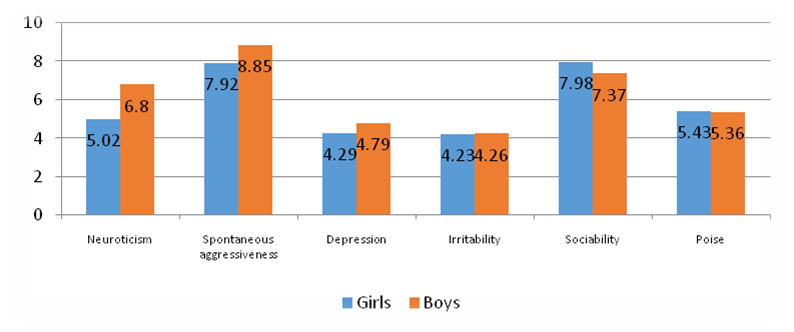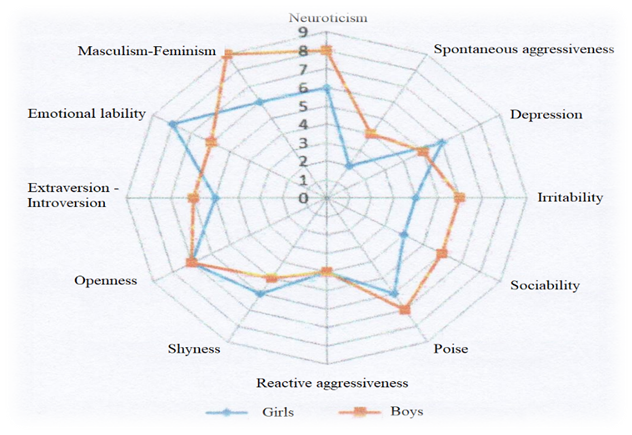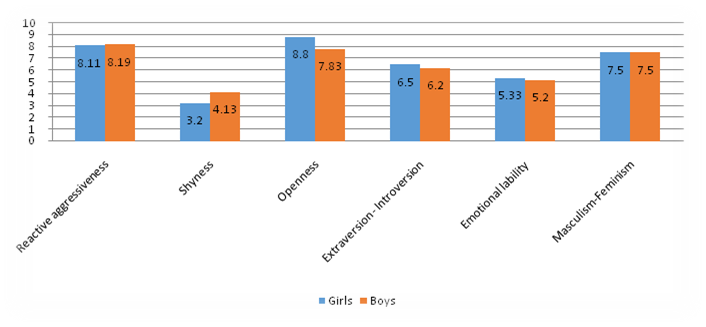Abstract
The study of the development of the personality of a teenager is of particular interest in modern pedagogy, since this period has a bright tendency to gradual growth and covers almost a full decade - from eleven to eighteen years of a person's life. Adolescence is a crisis stage in the development of personality, suggesting serious changes both at the physical and psychological-pedagogical level. The applied application of the “Freiburg Multifactor Personality Questionnaire” in the study of adolescent personality development (hereinafter referred to as FPI) provides a detailed diagnosis of personality traits. Based on this, it becomes relevant to study the development of the personality of adolescent children using the FPI personality questionnaire. The study involved 56 people; the respondents were divided into girls and boys. Student's T-test was used to identify statistically significant differences in the personality characteristics of adolescents, since it allows us to identify similarities and differences in the level of the studied trait. It made it possible to identify the difference between girls and boys with increased neuroticism, and many personality characteristics (aggressiveness, depression, irritability, sociability, poise, openness and emotional lability) are independent of gender as the dominant factor and are determined by individual psychological characteristics of personality, a set of processes, states and properties possessed man.
Keywords: Personality profilepersonality traitsteensFreiburg questionnaireFPI
Introduction
A person in the modern information society is understood as a creative, resourceful, proactive, constantly evolving person who is in harmonious relations with the environment and other people ( Khachaturova, 2018). Modern pedagogical science recognizes the activity and independence of adolescent children. Therefore, the educational process should be aimed at the development of adolescent children. From the age of the primary school, students need to be prepared for professional activities in a competitive environment in which each situation requires a creative approach, since it is well known that creative thinking is the engine of science, the key to progress. Adolescence is one of the critical periods of ontogenesis ( Khachaturova, 2016).
Problem Statement
Russian pedagogy is currently faced with problems related to fundamental socio-economic changes ( Pevzner, Sheraizina, Donina, Petryakov, & Aleksandrova, 2017; Pevzner, Shirin, Shaydorova, & Rakhkochkine, 2019). In addition, to meet the requirements of modern society, it is advisable to consider the process of development of adolescent children by the influence of factors that determine the conceptual model of any knowledge. The study of the development of the personality of a teenager with a modified form of the FPI questionnaire can help to solve this problem. Drawing up a “personality profile” will make it possible to use largely the important qualities of a teenager’s personality and contribute to their development.
The FPI method was created taking into account the experience of construction and application based on such questionnaires as the Oxford Questionnaire of Happiness (OHQ) ( Argyle, Martin, & Crossland, 1989), from the Oxford List (OHI) ( Elken, Francis, & Robbins, 2010), 29 points, with a choice of one of four options and different for each point ( Hills & Argyle, 2012); Kettel's 16-factor questionnaire, MMPI, EPI ( Vansovskaya, Gaida, & Gerbachevsky, 2012). To determine the developmental factors of a teenager’s personality, the study used the FPI questionnaire (form B – 114 questions), which was adapted and modified in 1989 at the Faculty of Psychology of Leningrad State University A.A. Krylov and T.I. Ronginsky ( Krylov, 2014). The Freiburg multi-factor personality questionnaire is included in the teaching materials of workshops on social psychology ( Vasilyeva, 2011). Rogov ( 1999) in the manual describes in detail the system of work with children of different ages. The FPI questionnaire is a reliable tool for practical and research purposes and the diagnosis of important personality traits. In scientific papers, it is often used for individual diagnostics ( Shamshikova & Belashina, 2010); in order to analyze the personality characteristics of adolescents for all factors, it has been studied little. For the successful formation of the basic universal educational actions of a modern teenager and taking into account his personality, it is most relevant. In this regard, the main goal of the work was to study the personality characteristics of older teenage children and a detailed description of the method, since it is quite well-known for practical psychological and pedagogical diagnostics, quite reliable and valid ( Krylov, 2014; Rogov, 1999).
Research Questions
-
It is to identify pronounced features in the personal development of girls and boys in adolescence by group analysis using the FPI method. -
It is to define criteria for important personality traits that influence development and underpin the educational activities of a modern school. -
It is to identify important elements of a teenager’s personality to increase motivation and quality of education in primary school. -
Comparison of average values for the factors of "FPI" in girls and boys of adolescence
For clarity, we present the obtained data graphically in the form of comparative histograms and describe the results obtained (Figure

Comparing the average group values, it is noticeable that neuroticism, as a personal property, is more pronounced in boys, 6.8 points, in the group of teenage girls, 5.02 points. It can be noted that no contradictions were found, since, at this age, girls are already significantly ahead of boys, and are already more formed and more resistant to various kinds of stress.
Confidence differences
To ascertain the reliability of the differences, Student's t-test was used. The obtained experimental value of the t-criterion turned out to be more than the tabular one (texp = 2.602, tcrit = 2.042, with p≤0.05). Therefore, the differences in the groups of teenage boys and teenage girls are statistically significant for this factor.
In order to find out how reliable these differences are, we used Student's t-test. The obtained experimental value of the t-test turned out to be less than the tabulated one (texp = 0.706, tcrit = 2.42, with p≤0.05). Therefore, the differences in the groups of teenage boys and teenage girls on this factor are statistically unreliable. The average values of depression (Figure
Purpose of the Study
It is to identify differences and general aspects in the indicators of the average group values of the severity of personality characteristics of boys and girls of adolescence using the FPI method and get reliable criteria for the personality characteristics of adolescents in the process of training and education.
Research Methods
Since adolescents aged 12 to 14 have certain age and gender differences in development ( Helsen, Vollebergh, & Meeus, 2000). 56 people took part in our study and we divided all respondents by gender: girls and boys. They were 28 boys and 28 girls 12-13 years old. All were notified of the purpose of the study, the study was conducted anonymously only, indicating gender. The study was conducted among teenage students of secondary school No. 129 of the Krasnogvardeisky district of St. Petersburg.
Statistically significant differences in testing
To identify statistically significant differences in the personality characteristics of adolescents, Student's t -test was used, since it allows us to identify similarities and differences in the level of the studied trait.
By Student's t -test, the arithmetic mean values, that is, the level of the attribute, are compared in two independent samples with equal dispersion and a random variable distribution corresponding to the normal type.
The arithmetic mean values and standard deviations can not be calculated independently, but the observation matrix can be processed in the Microsoft Excel package of the online program Freiburg Multivariate Personal Questionnaire. To do this, it is necessary to select the "Data Analysis" command in the "Tools" menu and select "Descriptive Statistics" in the dialog box that appears in the list of analysis tools and click "OK." Next, you need to enter the data range, place the necessary labels and a sheet with the calculation results opens. The critical value of tcrit is determined from the tables. If texptcrit, then the hypothesis is accepted. The critical value for this sample is 2.042 for ( = 0.05) ( Krylov, 2014).
Personality features of boys and girls in the same age category
For the purpose of the study, group results are presented, as well as personality characteristics of boys and girls who are in the same age category are analyzed. Figure

Based on the presented figure, we can immediately note what features in personality development prevail in girls and boys in adolescence.
For our test subject, such qualities as emotional lability and depression are more characteristic, whereas for a boy neuroticism, irritability, sociability are more characteristic. Equally, regardless of gender, these adolescents are united with openness and reactive aggressiveness. We presented data for two respondents, but by analogy, such profiles can be made for each subject.
Findings
Average values of “Freiburg Multifactor Personal Questionnaire” survey respondents
Among the subjects of both groups, depressive indicators are expressed as moderate, which indicates that adolescents, regardless of gender, that is, both boys and girls, are not prone to gloom, excessive sadness, a lowered mood, as well as there was no decrease in their interest in performing various types of activities, including educational ones, and apathy was not detected either.
Our respondents, regardless of gender, showed average estimates of balance, which indicate sufficient protection against stress factors based on confidence, optimism and activity.
Using Student's t-test, it was found that the experimental value of the t-test turned out to be less than the tabular one (texp= 0.871, tcrit = 2.042, at p≤0.05). Therefore, the differences between adolescents, depending on their gender, are not statistically significant for this factor. In other words, both boys and girls have approximately the same (average) level of balance and the same (average) level of irritability. Applying the Student's t-test, it was found that the experimental value of the t-test turned out to be less than the tabular (texp = 0.871, tcrit = 2.042, at p≤0.05). Therefore, the differences between adolescents, depending on their gender, are not statistically significant for this factor. Boys and girls have approximately the same (average) level of poise (Figure

The average reactive aggression factors in the group of boys are lower than the average group values in the group of teenage girls 8.11 points, in the group of boys 8.19 points (Figure
Boys and girls seek a confidentially frank interaction with other people with a high level of self-criticism. Using Student's t-test, it was found that the experimental value of the t-test turned out to be less than the tabular one (texp = 0.625, tcrit = 2.042, at p≤0.05). Therefore, the differences between boys and girls, according to this factor, are not statistically reliable and have approximately the same (average) level of emotional lability.
The average group values for the “masculism-feminism” factor in both groups are about 7.5 points (Figure
Using the Student's t-test, it was found that the experimental value of the t-test turned out to be less than the tabulated one (texp= 1, tcrit = 2.042, at p≤0.05). Therefore, the differences between girls and boys on this factor are not statistically significant
Conclusion
The use of the “Freiburg personality questionnaire” to determine the development of a teenager’s personality, as well as Student’s criterion, revealed that teenage girls differ from teenage boys in neuroticism, but such as aggressiveness, depression, irritability, sociability, poise, shyness, openness , extraversion, introversion, emotional lability are independent of gender as the dominant factor. Taking into account all of the above personality characteristics of the development of children of adolescence will help a modern teacher to achieve a high-quality learning process and harmonious development of personality.
References
- Argyle, M., Martin, M., & Crossland, J. (1989). Happiness as a function of personality and social encounters. In J. P. Forgas & J. M. Innes (Eds.), Recent advances in social psychology: An international perspective (pp. 189–203). Amsterdam: Elsevier Science.
- Elken, A., Francis, L. J., & Robbins, M. (2010). Internal consistency reliability of the Estonian translation of the Oxford Happiness Measure: Contributing to positive psychology in Estonia. In E. E. Wells (Ed.), Psychological well-being (pp. 223–230). New York: Nova.
- Helsen, M., Vollebergh, W., & Meeus, W. (2000).Social Support from Parents and Friends and Emotional Problems in Adolescence. Journal of Youth and Adolescence. 29(3), 319-335.
- Hills, P., & Argyle, M. (2012). The Oxford Happiness Questionnaire: a compact scale for the measurement of psychological well-being. Personality and Individual Differences, 33, 1073–1082.
- Khachaturova, K. R. (2018). Theoretical grounds of teaching in adolescence. Components of Scientific and Technological Progress, 2(36), 29-31. [in Russ]
- Khachaturova, K. R. (2016). The model of the educational process to develop the capacity for creativity in schoolchildren. Components of Scientific and Technological Progress, 3(29), 30-34. [in Russ]
- Krylov, A. A. (2014). Theoretical and applied questions of psychology. Part II. Applied problems of psychology. Ed. SPb: Publishing House of St. Petersburg University. [in Russ]
- Pevzner, M. N., Sheraizina, R. M., Donina, I. A., Petryakov, P. A., & Aleksandrova, N. V. (2017). Marketing-related activity in a heterogeneous educational organization. Revista Espacios. 38(40), 29-43.Venezuela.
- Pevzner, M., Shirin, A., Shaydorova, N., & Rakhkochkine, A. (2019). Internationalization of schools in Russia. Policy Futures in Education, 17(6), 715-731.
- Rogov, E. I. (1999). Handbook of a practical psychologist: Textbook. allowance: In 2 kN 2nd ed., Rev. and add. - M.: Gumanit. ed. center VLADOS,. — kN.1: system of work of the psychologist with children of different age. [in Russ]
- Shamshikova, O. A., & Belashina, T. V. (2010). Adaptation of the freiburg aggression factor research questionnaire (faf). The world of science, culture, education, 6-2 (25), 212-217. [in Russ]
- Vansovskaya, L. I., Gaida, V. K., Gerbachevsky, V. K. (2012). Workshop on experimental and practical psychology: Textbook. allowance / Ed. Krylov, A. A. - SPb: Publishing House of St. Petersburg University. [in Russ]
- Vasilyeva, I. V. (2011). Organizational and psychological diagnostics: textbook / I. V. Vasilyeva; Tyumen state University, Institute of psychology and pedagogy. Tyumen: Tyumen State University. [in Russ]
Copyright information

This work is licensed under a Creative Commons Attribution-NonCommercial-NoDerivatives 4.0 International License.
About this article
Publication Date
26 August 2020
Article Doi
eBook ISBN
978-1-80296-086-0
Publisher
European Publisher
Volume
87
Print ISBN (optional)
-
Edition Number
1st Edition
Pages
1-812
Subjects
Educational strategies, educational policy, teacher training, moral purpose of education, social purpose of education
Cite this article as:
Sherayzina, R. M., Khachaturova, K. R., & Aleksandrova, M. V. (2020). Methods Of Researching The Personality Development Of A Teen. In S. Alexander Glebovich (Ed.), Pedagogical Education - History, Present Time, Perspectives, vol 87. European Proceedings of Social and Behavioural Sciences (pp. 403-409). European Publisher. https://doi.org/10.15405/epsbs.2020.08.02.52

